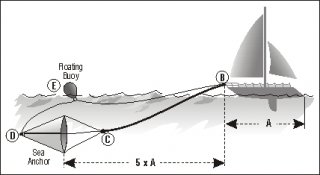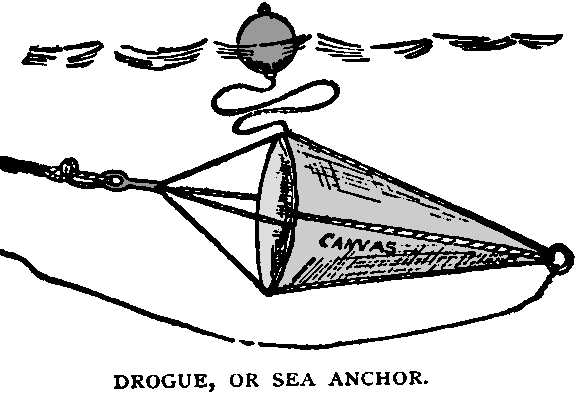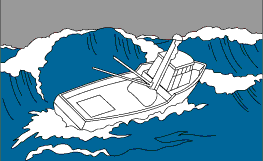Daily Update
Week 1: Module1: Tuesday January 29, 2013
Last night they were black lumps, the crashing the splashing each wave brining a smell of marine warmth. Adam and i rowed at midnight. two hours into a four hour shift. We ride into the beam (side) of the waves, by far the most uncomfortable. We rest. Adam rows gently with the waves, I stand in the stern. I hear the roar…out of the corner of our eye see a steep black face off port. We lean into it. A crash. we roll hard and the gunnels touch the water. White bubbles under moonlight. An oar, carbon and with a wood core snapped. small sundrys on deck float away.
We rested on sea anchor for about 10 hours… After the oar broke last night we decided run down wind since we could [not] go west. We went on sea anchor after david said we were heading to far south.
So what is a sea anchor and are they really carrying an anchor and enough cable to reach the bottom of the ocean?
In the images you can see that a sea anchor is really just a big parachute type device. These anchors are used to slow or even stop a boat from drifting in the case of a loss of power (e.g. not rowing) and it is important to keep yourself from difting too far off course. The other major use of a sea anchor is in rough seas. The sea anchor can allow you to align your boat either bow or stern to the oncoming waves, which is important as running abeam, with the waves at a right angle to the boat can have disastrous consequences. Check out the images to see which you think you would rather be in.
Here is an excerpt from Jordan’s book describing the deploying of the sea anchor during their 2006 North Atlantic row.
Crouched low behind the bow cabin, Dylan and Brad linked the anchor’s stainless steel shackle to the rope bridle on the bow. Fighting to keep his balance on the lurching deck, Brad fed the chute into the black water, making sure the nine feet of nylon fabric and its web of lines would open properly. As the chute blossomed, he let the two hundred feet of yellow rope run loosely through his hands to prevent the coils from snagging. Simultaneously Dylan fed out the longer trip line that would collapse the chute for easy retrieval once it was calm enough to row again. As the chute’s rope went taut, the wind and waves brought the full force of the tropical storm to bear and swung the bow hard into the waves. After the tense spin and jerk, our ride smoothed immediately as the narrow bow sliced the waves instead of taking them on the full twenty-nine feet of our broadside. -Jordan Hanssen




